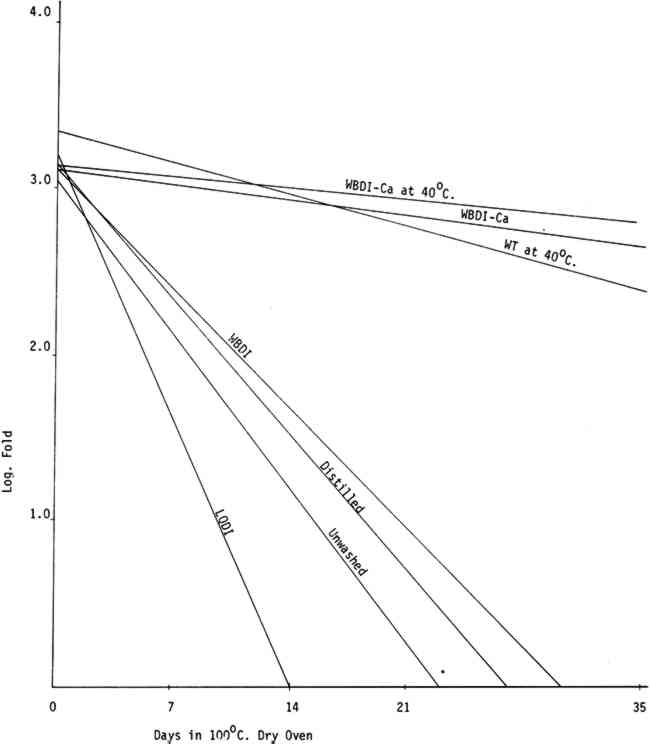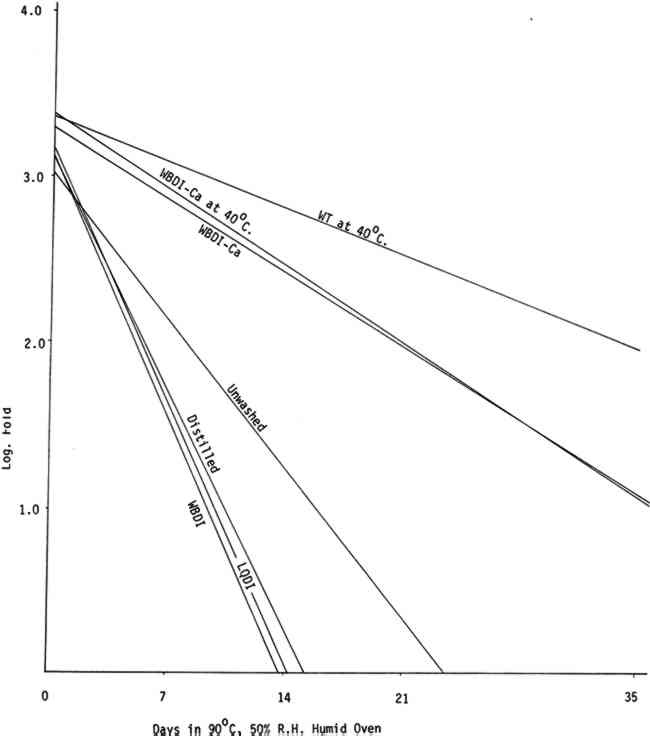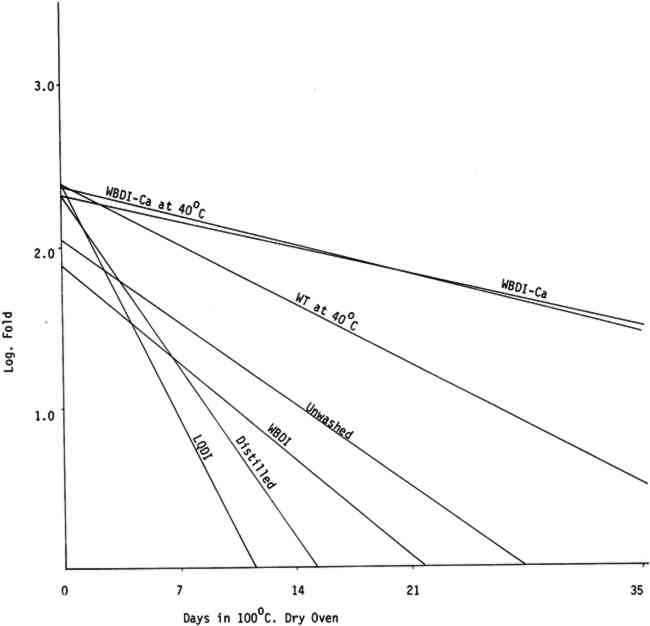THE EFFECTS OF WASH WATER QUALITY ON THE AGING CHARACTERISTICS OF PAPERLucia C. Tang, & Norvell M. M. Jones
3 RESULTS AND DISCUSSION3.1 Folding EndurancePAPER DEGRADATION was evaluated by measuring M. I. T. folding endurance at 1/2 kg load. Following Barrow11 and others12 the logarithm of folding endurance was taken as a linear function of days in the oven, and data was fitted to this relation by the method of least squares. The number of days for folding endurance to drop to a value of 1 was then determined by extrapolation. Life expectancy was determined as the number of days of artificial aging a paper could tolerate before folding endurance dropped to one fold. The value of treatment index was calculated as follows:
All washing treatments in our experiments increased initial folding endurance. After drying and humid oven aging, the paper washed in the three purest forms of water showed a pronounced tendency to drop in folding endurance when compared with papers washed in Washington tap water and the waters containing calcium and to a lesser extent with unwashed paper controls. That the unwashed controls should retain somewhat higher folding endurance compared with those washed in the purest waters was unexpected (See Tables IIa, IIb, IIIa, and IIIb). Paper samples TABLE IIa FOLDING ENDURANCE OF NEWSPRINT PAPER AFTER VARIOUS WASHING PROCESSES 100�C. DRY OVEN ACCELERATED AGING TABLE IIb FOLDING ENDURANCE OF NEWSPRINT PAPER AFTER VARIOUS WASHING PROCESSES 90�C. 50% R. H. HUMID OVEN ACCELERATED AGING TABLE IIIa FOLDING ENDURANCE OF FOLDUR KRAFT PAPER AFTER VARIOUS WASHING PROCESSES 100�C. DRY OVEN ACCELERATED AGING TABLE IIIb FOLDING ENDURANCE OF FOLDUR KRAFT PAPER AFTER VARIOUS WASHING PROCESSES 90�C. 50% R. H. HUMID OVEN ACCELERATED AGING
The relative life expectancy of paper washed in WBDI-Ca, WBDI-Ca at 40�C, and WT at 40�C varied with the aging method. In dry oven aging, the newsprint and Foldur Kraft samples washed in WBDI-Ca or in WBDI-Ca at 40�C had twice the life expectancy of paper samples washed in WT at 40�C. After humid oven aging, however, paper samples washed in WT at 40�C retained slightly greater folding endurance than the samples washed in WBDI-Ca at 40�C. There was no significant differences for 1, 2, and 3 hour washings. 3.2 BrightnessTABLES IVa, IVb, Va, and Vb show the effect of various washing processes on paper brightness after both dry and humid oven aging. After dry and humid oven aging newsprint washed in the three purest waters lost about the same number of brightness units as the unwashed paper. Newsprint washed in the three calcium containing water consistently retained more of its original brightness after aging than the unwashed sample. TABLE IVa THE EFFECT OF VARIOUS WASHING PROCESSES ON NEWSPRINT PAPER BRIGHTNESS 100�C. DRY OVEN ACCELERATED AGING TABLE IVb THE EFFECT OF VARIOUS WASHING PROCESSES ON NEWSPRINT PAPER BRIGHTNESS 90�C. 50% R. H. HUMID OVEN ACCELERATED AGING TABLE Va THE EFFECT OF VARIOUS WASHING PROCESSES ON FOLDUR KRAFT PAPER BRIGHTNESS 100�C. DRY OVEN ACCELERATED AGING TABLE Vb THE EFFECT OF VARIOUS WASHING PROCESSES ON FOLDUR KRAFT PAPER BRIGHTNESS 90�C. 50% R. H. HUMID OVEN ACCELERATED AGING Foldur Kraft behaved similarly to newsprint on dry aging; but on humid aging all washed Foldur Kraft was improved in brightness retention in comparison with the unwashed sample. 3.3 Chlorine, Iron, Copper, and Calcium Contents of the Wash Waters with Their Effects on Folding Endurance and Accelerated Aging of the Washed PaperANALYSES OF WASHINGTON municipal water are available from the Washington Aqueduct Division. The metal analyses in water9, 13 and the metal content in papers9 were determined by flameless atomic absorption spectroscopy. Analyses of the water used in the several washing systems are given in Table VI. The metal content of the papers after washing is shown in Table VII. In washed papers the iron content varied between 84ppm and 143ppm, which is not considered significant. TABLE VII IRON, COPPER, AND CALCIUM CONTENT FROM VARIOUS WASHING PROCESSES The paper washed in Washington tap water or in WBDI-Ca water contained twice as much calcium as the unwashed papers. The paper treated with the three purest waters had a slightly lower calcium content than the unwashed paper. The WBDI-Ca water picked up 0.010ppm of copper in passing through about 12 feet of copper pipes. The WBDI-Ca water which passed through the heating tank system picked up even more, 0.037ppm of copper. The WT at 40�C and WBDI-Ca at 40�C contained approximately the same amount of copper, although papers washed in WBDI-Ca at 40�C picked up much more during the washing process. Since copper The only wash water to contain chlorine was the Washington tap water at 40�C. In this 0.6ppm chlorine was found, using the ortho tolidine test with the Hellige comparator. This is a rather small amount of chlorine. There does seem to be an indication in Tables IIa, IIIa, and Figure 3 that it has attacked the cellulose slightly, in comparison with WBDI-Ca or WBDI-Ca at 40 A large change in the aging characteristics of the paper came when the paper was washed in the distilled and deionized waters. This is clearly shown in Figures 3, 4, 5, 6, and the treatment index values of Tables IIa, IIb, IIIa, and IIIb. These purified waters acted to remove the protective calcium from cellulose and thus made it more susceptible to the degradative effects of accelerated aging. Added calcium ions to the deionized water increased the concentration of calcium in the treated samples and thus improved their performance on heat aging. WBDI-Ca by this result, should have given excellent results with the paper, and it did for dry oven aging. Results for humid oven aging, however, were less pleasing. Williams et al.3, Czepiel14, and
3.4 pH of the Paper from the Various Wash WatersTHE pH AND TITRATION values obtained from the washed papers are shown in Table VIII. The three highest purity waters gave paper with pH values from 5.0 to 5.4. The pH values of the paper washed in Washington tap water at 40�C were higher than those washed in WBDI-Ca or WBDI-Ca at 40�C. The higher pH values gave the lower titratable acidities in most cases. TABLE VIII pH AND TITRATION FROM VARIOUS WASHING PROCESSES Although the papers washed in pure waters increased in pH, the predicted life generally decreased. When waters containing calcium were used, the pH increased to A continuation of this study will include testing to determine how the choice of water affects the pH of washed papers during and after accelerated aging. |




